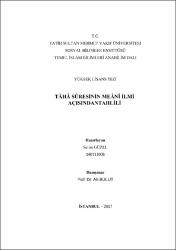| dc.contributor.advisor | Bulut, Ali | |
| dc.contributor.author | Güzel, Selim | |
| dc.date.accessioned | 2017-04-27T11:53:38Z | |
| dc.date.available | 2017-04-27T11:53:38Z | |
| dc.date.issued | 2017 | |
| dc.date.submitted | 2017 | |
| dc.identifier.citation | GÜZEL, Selim, Tâhâ sûresinin meânî ilmi açısından tahlili, Fatih Sultan Mehmet Vakıf Üniversitesi Sosyal Bilimler Enstitüsü Temel İslam Bilimleri Anabilim Dalı, Yayımlanmamış Yüksek Lisans Tezi, İstanbul 2017 | en_US |
| dc.identifier.uri | https://hdl.handle.net/11352/2462 | |
| dc.description.abstract | Tâhâ sûresini meânî ilmi açısından inceleyen bu çalıĢma giriĢ, üç bölüm ve sonuçtan oluĢmaktadır. GiriĢ bölümünde çalıĢmanın önemi, amacı, kaynakları, Tâhâ sûresi ve meânî ilminin genel çerçevesi hakkında bilgiler verilmiĢtir.
Ġlk bölümde haber ve cümle hakkında bilgiler verildikten sonra sûrede mevcut olan haberi cümleler, bu cümlelerin gayeleri, inĢâ ve bununla bağlantılı olarak emir, nehiy, istifhâm, nida ve bunların sûredeki gayeleri açıklanmıĢtır.
Ġkinci bölümde sûredeki müsnedün ileyh ve müsnedin durumları ile filin müteallakları ve sözün zâhirî duruma uygun gelmemesi konuları ele alınmıĢ, son bölümde ise sûredeki kasr, fasıl, vasıl, îcâz ve itnâb üslupları incelenmiĢtir. | en_US |
| dc.description.abstract | This study which analyzes the sura of Tâhâ in respect of meânî science consists of introduction, three chapters and result. Within the introduction part information has been given about the importance, purpose and resources of the study and about the general framework of sura of Tâhâ and meânî science.
In the first chapter, after giving general information about haber and sentence; existing haberi sentences in the sura, purposes of these sentences, inĢâ and in relation with this; order, prohibition, question, vocative and their purposes within the sura have been explained.
In the second chapter states of musnedun ileyh and musned within the sura, mutellaks of the verb and subjects where the word doesn‟t show compliance with the ostensible situation were evaluated. In the last chapter styles of kasr, fasıl, vasıl, îcâz and itnâb have been analyzed. | en_US |
| dc.language.iso | tur | en_US |
| dc.publisher | Fatih Sultan Mehmet Vakıf Üniversitesi, Sosyal Bilimler Enstitüsü | en_US |
| dc.rights | info:eu-repo/semantics/openAccess | en_US |
| dc.title | Tâhâ Sûresinin Meânî İlmi Açısından Tahlili | en_US |
| dc.type | masterThesis | en_US |
| dc.contributor.department | FSM Vakıf Üniversitesi, Sosyal Bilimler Enstitüsü | en_US |
| dc.relation.publicationcategory | Tez | en_US |
| dc.contributor.institutionauthor | Güzel, Selim | |



















